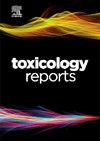斑马鱼早期发育中致畸物诱导的畸形和基因表达的比较分析
Q1 Environmental Science
引用次数: 0
摘要
斑马鱼胚胎被广泛用于发育毒性测试。然而,遗传背景影响致畸化合物易感性的程度仍不完全清楚。在这里,我们使用五种常用的斑马鱼品系,AB、TU、RW、WIK和PET,评估了对六种模型致畸原的表型和转录组反应的株间变异性。所有的测试化合物,丙戊酸、羟基脲、甲氨蝶呤、阿维甲素、托吡酯和布洛芬,都引起了浓度依赖性的发育毒性,其特征是中等剂量的畸形和高浓度的致命性。尽管毒理学特征不同,但表型结果的发生率和严重程度在不同菌株之间是高度一致的。在暴露于丙戊酸、羟基脲和华法林后进行转录组学分析,揭示了强烈的剂量依赖性基因表达变化,这些变化在菌株之间很大程度上是保守的。主成分分析表明,化学浓度,而不是菌株,是转录变异的主要驱动因素。在基线或低剂量水平上观察到轻微的菌株特异性差异,但没有改变反应的总体方向或幅度。这些发现表明,来自不同遗传背景的斑马鱼胚胎对致畸物表现出广泛保守的发育和分子反应。最小的品系间变异支持使用任何野生型品系、转基因品系,甚至远交种群体进行发育毒性试验,而不影响敏感性或可重复性。我们的研究加强了斑马鱼作为调节毒理学强健脊椎动物模型的适用性。本文章由计算机程序翻译,如有差异,请以英文原文为准。
Comparative analysis of teratogen-induced malformations and gene expression across zebrafish strains in early development
Zebrafish embryos are widely used in developmental toxicity testing. However, the extent to which genetic background influences susceptibility to teratogenic compounds remains incompletely understood. We here evaluated inter-strain variability in both phenotypic and transcriptomic responses to six model teratogens using five commonly utilized zebrafish strains, AB, TU, RW, WIK, and PET. All test compounds, valproic acid, hydroxyurea, methotrexate, acitretin, topiramate, and ibuprofen, elicited concentration-dependent developmental toxicity characterized by malformations at moderate doses and lethality at higher concentrations. Despite distinct toxicodynamic profiles, the incidence and severity of phenotypic outcomes were highly consistent across strains. Transcriptomic analysis was performed following exposure to valproic acid, hydroxyurea, and warfarin, revealing strong, dose-dependent gene expression changes that were largely conserved among strains. Principal component analysis demonstrated that chemical concentration, rather than strain, was the dominant driver of transcriptional variation. Minor strain-specific differences were observed at baseline or low-dose levels but did not alter the overall direction or magnitude of response. These findings demonstrate that zebrafish embryos from diverse genetic backgrounds exhibit broadly conserved developmental and molecular responses to teratogens. The minimal inter-strain variability supports the use of any wild-type strain, transgenic line, or even outbred population in developmental toxicity testing without compromising sensitivity or reproducibility. Our study reinforces the suitability of zebrafish as a robust vertebrate model in regulatory toxicology.
求助全文
通过发布文献求助,成功后即可免费获取论文全文。
去求助
来源期刊

Toxicology Reports
Environmental Science-Health, Toxicology and Mutagenesis
CiteScore
7.60
自引率
0.00%
发文量
228
审稿时长
11 weeks
 求助内容:
求助内容: 应助结果提醒方式:
应助结果提醒方式:


